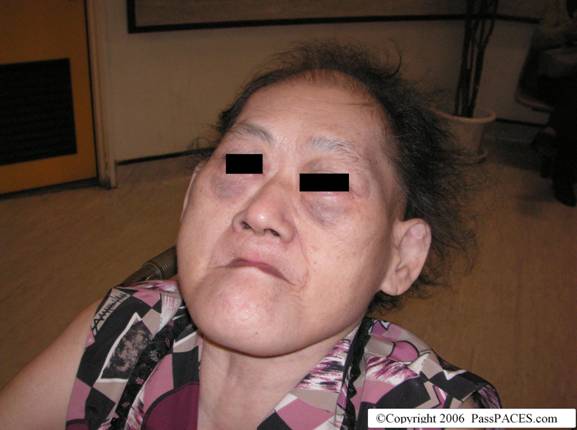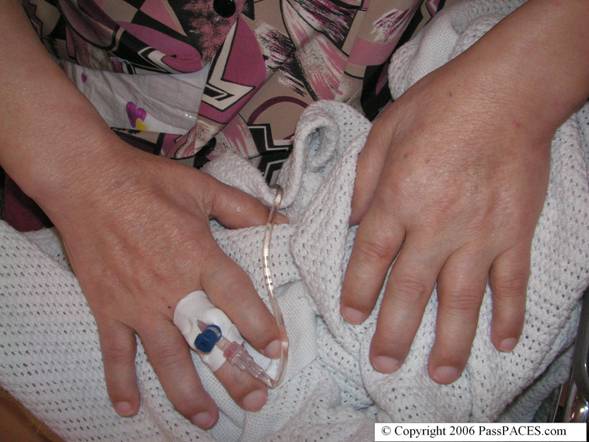
|
|
|||||
|
|
|
|
|
|
|
YOUR LATEST ISSUE ABOUT MRCP PACES IS HERE!
Inspect this lady and proceed.

Discussion:
This case is always very popular in MRCP station 5. A lot of candidates can pick up the diagnosis but are unable to perform well in this case. It is a gift if you are asked about acromegaly in MRCP PACES. I always like to do the following if I suspect acromegaly in exam,
![]() Spend a few seconds in general inspection
Spend a few seconds in general inspection
![]() Start off by examining the patient’s hand, you notice that she has spade –like ,sweaty hand, the skin is thickened and doughy.
Start off by examining the patient’s hand, you notice that she has spade –like ,sweaty hand, the skin is thickened and doughy.
![]() Check for carpal tunnel syndrome
Check for carpal tunnel syndrome
![]() Look at the face- check for prognathism ( causing malocclusion of jaw), prominent supra-orbital ridges, wide spaced interdental space, big tongue.
Look at the face- check for prognathism ( causing malocclusion of jaw), prominent supra-orbital ridges, wide spaced interdental space, big tongue.
![]() Offer to look for skin tag ( molluscum fibrosum) at axilla
Offer to look for skin tag ( molluscum fibrosum) at axilla
![]() Look at lower limbs for pitting oedema to suggest high cardiac output failure
Look at lower limbs for pitting oedema to suggest high cardiac output failure
![]() Check for proximal myopathy by asking patient to squat down
Check for proximal myopathy by asking patient to squat down
![]() Check for bitemporal hemianopia ( acromegaly tends to be due to macroadenoma)
Check for bitemporal hemianopia ( acromegaly tends to be due to macroadenoma)

After showing all the positive signs, suggest to examiners you would like to complete your physical examination by,
![]() Check her Blood Pressure which is a indicator for active disease
Check her Blood Pressure which is a indicator for active disease
![]() Check urine for glycouria/ haematuria due to possible concomitant diabetes mellitus or stone because of hypercalciuria
Check urine for glycouria/ haematuria due to possible concomitant diabetes mellitus or stone because of hypercalciuria
![]() Check fundus to for changes of DM/hypertension and angiod streak
Check fundus to for changes of DM/hypertension and angiod streak
![]() Compare patient with old photos
Compare patient with old photos
![]() Examine CVS to look for heart failure, neck for goiter and abdomen for hepatosplenomegaly
Examine CVS to look for heart failure, neck for goiter and abdomen for hepatosplenomegaly
Common questions examiners would ask you,
1) What are the indicators for disease activity in acromegaly?
2) How do you manage investigate this lady?
Conclusion:
This lady has acromegaly due to pituitary macroadenoma.
Extra points:
1)Indicators for disease activity are uncontrolled symptoms such as headache, sweating, presence of skin tags, uncontrolled Diabetes, hypertension and progressive visual impairment.
2) After your presentation, always tell the examiners what you think about the disease activity.
3)
Most important test to diagnose acromegaly is non-suppressibility of growth hormone level after an oral glucose tolerance test.
| Case ID: 2 | Created: 15 September 2006 |
Station 4: You are the SHO in charge of Neurology Ward.
Subject: Miss Sylvia, 24-year old
Miss Sylvia was diagnosed to have epilepsy about 6 months ago but she has failed to attend your neurology clinic follow up. For the past one month, she has been recurrently admitted to your hospital due to seizure and you found out that she has not been taking her medications regularly. Due to her work as a school teacher, you also noticed that she is still driving to school. Currently, she is admitted in your neurology ward and your task is to discuss the management of her epilepsy.
You have 14 min until the patient leaves the room followed by 1min for reflection before the discussion with the examiners.
Discussion:
Do the following if possible
![]() Introduction
Introduction
“ Miss Sylvia, I am Dr……., the SHO in charge of this ward. How do you feel today?”
![]() Assess her understanding about the illness
Assess her understanding about the illness
“ I know that you were admitted to our ward due to fit one day ago, did anyone tell you about your problem?”
![]() Explain the diagnosis based on patient’s understanding for the illness
Explain the diagnosis based on patient’s understanding for the illness
You need to know about patient’s understanding about an illness before you exaplain about the illness. Some patients might know a lot about their own illness, therefore, you can go straight to more ‘advanced’ discussion with patients.
Generally, when you talk about an illness, try to cover the following,
![]() General information about an illness. Such as “Epilepsy is due to some abnormal brain activity that causes you to have abnormal and uncontrolled body movement.”
General information about an illness. Such as “Epilepsy is due to some abnormal brain activity that causes you to have abnormal and uncontrolled body movement.”
![]() Possible complications about an illness if left untreated
Possible complications about an illness if left untreated
![]() Possible treatment- Remember that besides medications, always talk about non-pharmacological management. Such as in this patient, besides anti-epileptic medications, tell patient that she must learn to protect herself by avoiding involvement of high-risk recreational activity such as swimming. Always assess her social support because someone needs to know how to take care of an epileptic patient when there is a seizure.
Possible treatment- Remember that besides medications, always talk about non-pharmacological management. Such as in this patient, besides anti-epileptic medications, tell patient that she must learn to protect herself by avoiding involvement of high-risk recreational activity such as swimming. Always assess her social support because someone needs to know how to take care of an epileptic patient when there is a seizure.
![]() Other important issues pertaining to the illness- such as in this patient, the patient might want to know whether she would pass this illness to next generation. If you encounter a female patient in your exam, always think of the possible impact of the disease and its treatment towards pregnancy and lactation. Besides these issues, in this case, another issue crops up for you to discuss with the patient is the issue of driving.
Other important issues pertaining to the illness- such as in this patient, the patient might want to know whether she would pass this illness to next generation. If you encounter a female patient in your exam, always think of the possible impact of the disease and its treatment towards pregnancy and lactation. Besides these issues, in this case, another issue crops up for you to discuss with the patient is the issue of driving.
Actually, my friend failed this station in his MRCP PACES a few years back because he did not find out the following,
1) The patient refused to eat the medications because she was pregnant at that time and she was worried about the side effects of the medications to her baby.
2) My friend did not find out what was the social support for this lady. Actually, her husband was working outstation and there was no way for her to go to work except driving her own car.
3) The patient was very worried about passing the disease ( epilepsy) to her baby and actually wanted to ask my friend about abortion. However, my friend just ignored her because this task was not mentioned in the paper.
To see previous issues, click here! To send a quick comment, click here!